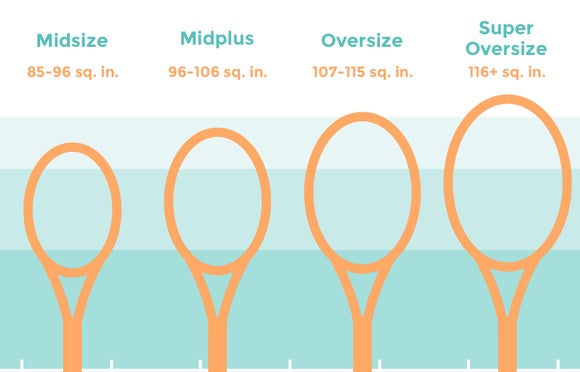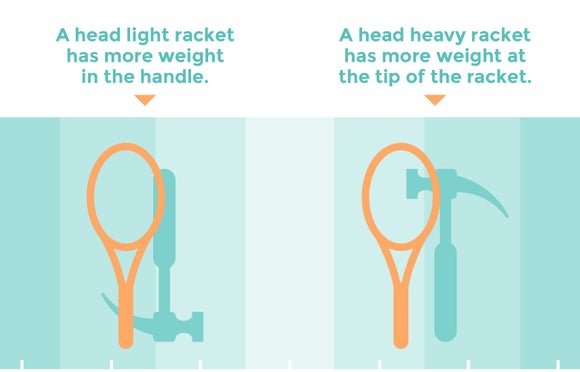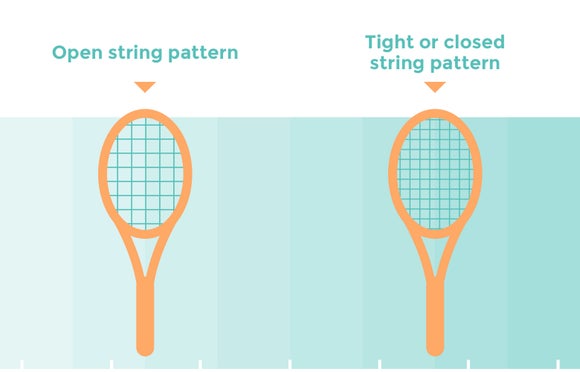Selecting the Right Tennis Racquet
If you buying your first racquet or upgrading from your current racquet, choosing the right racquet can seem daunting. To make this process a little easier, here’s a primer on racquet characteristics and how they affect performance.
Getting started
To begin breaking down the vast selection of tennis racquets on the market, we'll divide them into four primary categories: power, tweener and modern player's and traditonal player's racquets. We'll dive into each of these categories below.
Power racquets
This is the term used by racquet manufacturers for power-oriented racquets. In most cases, these racquet models feature oversize to super-oversize heads (107-135 square inches), are lightweight (8-9.5 ounces), longer (27-29 inches) stiffer and are balanced head heavy (or evenly balanced) to retain enough weight in the hitting zone. Designed for players with shorter, slower swings who want more power from the racquet.
Tweener racquets
Originally getting its name as a category of racquets sitting (be)tween power racquets and player's racquets, tweeners have become the most popular type of racquet Tennis Warehouse offers. A tweener borrows some of the lightness and power of the power racquets and mixes it with some of the control of the player's racquets. These racquets are often light to medium weight (9.5-11 ounces), balanced anywhere from slightly head light to slightly head heavy and have midplus (98-104 square inches) heads.
The power level typically ranges from low-medium to medium-high power, making them most appealing to intermediate through advanced players. Tweener racquets tend to be very spin-friendly thanks to possessing a light and fast feel combined with a healthy midplus headsize.
Modern player's racquets
The move to a heavy topspin playing style at the top of the game has created the modern player's racquet. These racquets are lighter and faster than traditional player's racquets and offer midplus headsizes. Modern player's racquets are perfect for attacking the ball at an aggressive angle for maximum spin. The power level is similar (if not identical) to tweener racquets, and the strung weight typically falls between 11-12 ounces. Headsizes of modern player's racquets are often right around 98-100 square inches.
Traditional player's racquets
This category denotes racquets that would be used by professionals, high-level club and college team players. These models are typically heavier in weight (11.5-12+ ounces), have smaller heads (85-98), thinner, more flexible beams and are balanced head light to retain maneuverability. The result is a low-power racquet, designed for players who provide their own power and prefer a racquet that offers control. Most player's racquets are standard length but there are a few extended length options.
Factors to consider
Head size
Power is directly related to head size; a larger head will provide more power than a smaller head, all other things being equal. A larger head also offers a larger hitting area and sweetspot, which results in more forgiveness on off-center hits. Today’s racquets are offered in head sizes ranging from 93 to 135 square inches, with the most common being 97-100. Racquets at, or close to, 100 square inches offer a solid blend of power and control for many players. Generally speaking, a smaller racquet head appeals to more accomplished players seeking more control, while larger racquets appeal to beginning and intermediate players seeking more power and a larger sweetspot.
Length
The standard length for an adult tennis racquet is 27 inches, but racquets are available in lengths ranging from 26.5 to 29 inches (29 inches is the legal maximum for tournament play). A longer racquet provides more reach on groundstrokes, added leverage on serves and slightly more power overall than standard length racquets; all other things being equal. The added length of longer racquets results in a higher swingweight, which means a little more effort is required to maneuver the racquet. Many power racquets are lighter to keep them maneuverable even at longer lengths.
Weight and balance
These two characteristics most influence how a racquet feels when you pick it up and when you swing it on the tennis court.
Weight: A heavy racquet is more powerful, more stable and transmits less shock than a lighter racquet (all other things being equal). The extra weight of a heavy racquet helps it win the battle at contact when the stringbed collides with the ball. The result is a stable feel and the sense the racquet is plowing through the ball. We often refer to racquets with these favorable qualities as having "good plow through" in our product descriptions and reviews. From the baseline players with long fast strokes will find good depth and pace from heavier racquets. At net and on service returns the added stability is a nice benefit. Conversely, a lighter racquet is more maneuverable, and thus, a player is able to position the racquet easier and generate lots of spin (thanks to the easier access to a faster swing). On court players can whip the ball with spin to help generate better angles, get lobs and passing shots to quickly dip inside the lines and maneuver the racquet easily during quick exchanges at net. Keep in mind, you can always add weight to a racquet if it’s too light. Reducing racquet weight, however, is almost impossible.
Balance: A racquet can be one of three things when it comes to balance: head light, head heavy or even balanced. A head-light racquet will have more of its mass located toward the handle end of the racquet. Most traditional player's racquets are head light to help keep them feeling maneuverable even though they are the heaviest type of racquet. Lightweight power racquets tend to be head heavy. With plenty of mass located toward the head of the racquet, some stability is retained despite the racquet having a light overall weight. We are then left with the medium weight racquets, which come in at an even balance or close to it. When the mass is distributed evenly throughout the racquet a blend of stability and maneuverability can be achieved without making the racquet too heavy or too light.
Frame stiffness
We measure frame stiffness and give each frame a score (RA). You will see the RA in the spec tables on our racquet description pages. Here's a general breakdown of how to decode the measurements:
Flexible frame = 63 and below
Medium stiffness = 64 to 67
Stiff frame = 68 and above
The amount a frame deflects during ball contact directly affects its power potential. A stiffer racquet bends less, thus depleting less energy from the ball. A flexible racquet bends more, resulting in more energy loss. A common myth among players is that a flexible racquet, that bends back more, returns more power to the ball due to a catapult-effect. The ball remains on the strings for 3-5 milliseconds, much shorter than it takes a frame to recover. Consequently, a racquet frame doesn’t "return" energy to the ball, it absorbs energy - either more or less, depending on stiffness. Stiffer racquets don’t deflect as much on impact, resulting in less power drain than a flexible racquet.
Frame stiffness doesn’t only affect power. Control and comfort are at stake. Generally speaking, a racquet that offers more power provides less control. However, this is largely dependent on player type, ability and the type of string installed in the racquet.
"A common myth among players is that a flexible racquet, that bends back more,
returns more power to the ball due to a catapult-effect."
An advanced player may prefer the feel and control of a flexible racquet because he or she has a long, fast swing and provides his or her own power. A beginning or intermediate player, though, may prefer a stiffer racquet for a better blend of control and power for his or her stroke style. Many advanced players also like a stiffer and more powerful frame when combined with a stiffer and control-oriented string. The result allows the advanced player to hit with lots of power and spin. The combination of a powerful racquet with a stiff and spin-friendly string has come to define the modern power game at the elite level. However, a stiff racquet combined with a stiff string can result in comfort issues for amateur players.
To a certain point, stiffer racquets are generally less comfortable than more flexible racquets. A very stiff frame will transmit more impact shock to the wrist, elbow and shoulder than a medium stiff frame. Comfort is difficult to measure - each player has a different perception of what feels comfortable. However, players with arm and/or shoulder problems should look at frames with an RA of 66 or less.
Swingweight
Swingweight is a measurement of how heavy a racquet feels when you swing it. Racquets with higher swingweights are harder to swing, but they offer more comfort, power and stability at impact. Racquets with lower swingweights are easier to swing, but they offer less stability and comfort, espeically when playing aganst higher levels of pace.
Advanced players prefer higher swingweights because it helps them redirect the pace of big hitting opponents. It also enables them to hit with high levels of power. Beginner and intermediate players prefer a lower swingweight because it gives them easier acceleration, which not only helps them position the racquet effectively, but it also makes it easier for them to generate the higher stroke speed required for effective pace and spin.
Low swingweight = 305 and below (Manueverable, suitible for beginners)
Medium swingweight = 310 to 325 (Moderate maneuverability and stability, suitible for all ability levels, but ideal for intermediates)
High Swingweight = 325 and above (Very stable, suitable for advanced players)
String pattern
Often overlooked by many recreational players, the string pattern of a racquet influences many aspects of its overall performance and feel. String patterns are often described as open or closed.
An open string pattern will deflect more on impact than a denser pattern, providing greater ball rebound and a higher launch angle. Strung at the same tension (in similar racquets) an open string pattern should feel livelier. In other words, a player will find easier access to depth and pace. Open string patterns also allow the main strings to deflect more and with certain string types the main strings will snap back into position providing more spin. The price one may pay for this, though, is reduced string durability. The increase in string movement results in more abrasion which can cause faster string breakage.
A closed string pattern won’t deflect as much upon ball impact, resulting in less rebound energy. Many players find the response of a closed pattern to offer a more controlled feel. While the stringbed doesn't allow for as much string movement for spin generation, the added control of the closed pattern allows players to swing quickly and therefore the ability to get the ball spinning quickly. More closely spaced strings can last longer and that allows the player to utilize softer, thinner and more feel oriented strings without sacrificing too much durability.


